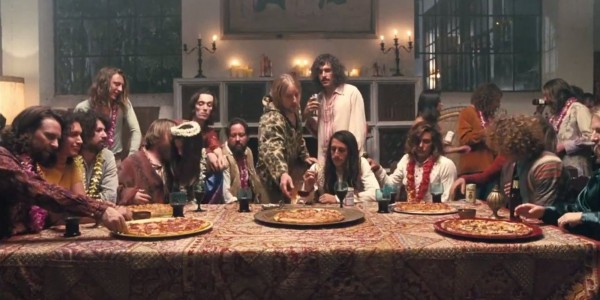Inherent Vice is going to take a second viewing to really sink in. Not in the way The Master required one more look to parse some of the stranger moments; here it’s to untangle this balled-slinky of a plot. Anderson’s plots have never been as labyrinthian as this, or at least they’ve never been presented that way. Magnolia has a million characters doing a billion different things (Boogie Nights too), but it’s shockingly easy to follow. So blame this on Thomas Pynchon, maybe. He seems to create a tachyon field with his prose that scrambles my brain in a way that few authors are capable. I only just read The Crying of Lot 49 this year, following a handful of attempts to start Gravity’s Rainbow. His thoughts pile up on the page, never not moving forward, but often interrupting one another mid-sentence. It’s Joycean, but as in the case with Inherent Vice, totally silly, like when he names the central setting “Gordita Beach” or a character “Coy.”
No one else could have adapted this material as well as Anderson did and part of me thinks no one else should even try. The material gives him the opportunity to finally make his version of The Long Goodbye, upping that film’s stakes to something a little closer to Chinatown, only to bring things back around to a more personal conclusion, like reconnecting a family of junkies. Doc Sportello (Joaquin Phoenix) is a Lorax-type, speaking for the trees in the face of a cyclopean infrastructure that eats the rich and the poor equally. For a film that you could almost confuse as a stoner comedy, it’s far more sincere than all of that. Doc answers the call to look for his ex-old-lady’s (Shasta Fay Hepworth, played by Katherine Waterson) missing boyfriend, a married tycoon by the name of Mickey Wolfman (Eric Roberts). That’s not so weird, but then Doc picks up another case and it also involves Wolfman somehow, sparking all of the paranoid synapsis in Doc’s brain. But the whole thing kicks off because Doc still cares a whole hell of a lot about Shasta. There’s no big payday waiting at the end of this for him, just her. And in spite of (or because of) his perma-high, he’s actually a great detective, connecting dots the straight-laced Det. “Bigfoot” Bjornsen (Josh Brolin) can’t. Unlike in Lot 49, the paranoia cuts both ways here, if not a force for good, then at least guiding Doc down a path where he can do good.
Phoenix is good here as the kind of detective who always follows his nose, be it from one clue to the next or into a massive, unaccompanied pile of cocaine. This is as close to a movie-star performance he’s given since Walk The Line and even that was closer to karaoke (musical and otherwise). His Doc is a little too old to be behaving the way he does, but unbothered by the fact that he’s one of the last guys at the party. On the opposite end of the spectrum (for character, not quality) is Josh Brolin, who has a blast playing the kind of cop his character wants to play on TV (the extra work is all but dried up). He does things to a chocolate banana that must be seen to be believed.
But the real revelation here is Katherine Waterson as Shasta. There’s something off about her almost immediately and it goes beyond the awkward nature of walking into her ex-boyfriend’s apartment to ask for help. She looks like she’s smiling through tears, but the dam doesn’t burst until later in the film when she reappears, almost ghost-like. Doc doesn’t expect her to be there and really, why is she? Where did she come from? She tips the story (or at the very least, that scene) into something spooky and confounding. She doesn’t have a lot of screen time, but when her dysfunction overtakes the polite, pretty facade, there’s nothing else like it this year. That scene exists in a candle-lit snow globe of bad decisions and I can’t wait to see it again.
There’s probably a lot more I could say about the movie, but more than anything I want to see it again. The more I’ve thought about it, despite any perceived differences from There Will Be Blood or The Master, this is yet another examination of the people who built and bought California, sharing equal footing with either of those films. It’s not as silly as the trailers make it out to be, nor is it some gloomy mapping of the Reagan-era putting a firehose to the flower children. It exists somewhere in the middle. It’s idiosyncratic and gorgeous (Robert Elswit killing it yet again) in the way that all of Anderson’s films have been up to this point. And if its thrown me for a loop, then what else is new? Did anyone expect Punch-Drunk Love after Magnolia? Or There Will Be Blood after that? The end result is always the same: a film no one else could have made. It has my respect and hopefully the second viewing will get my love too.
